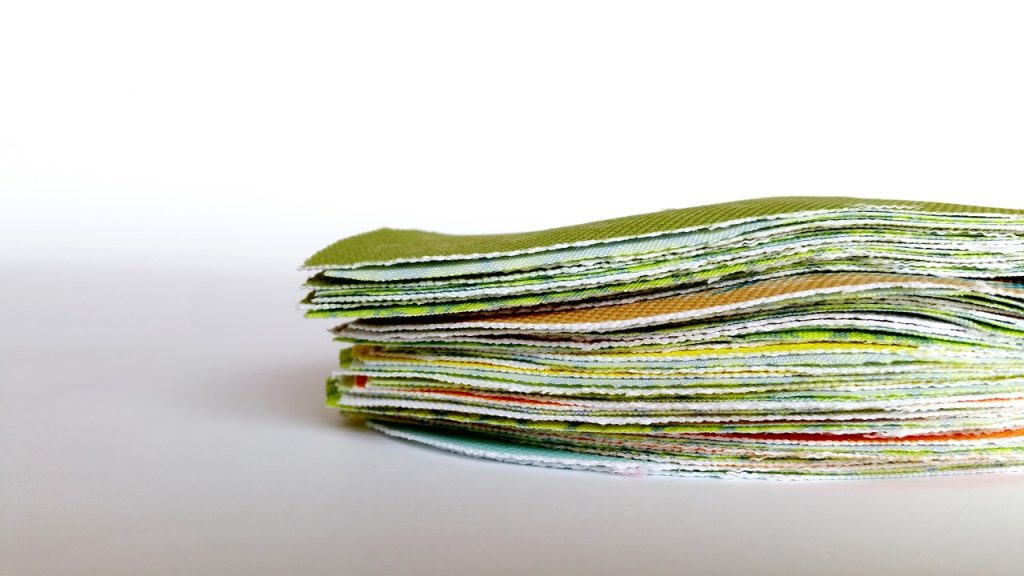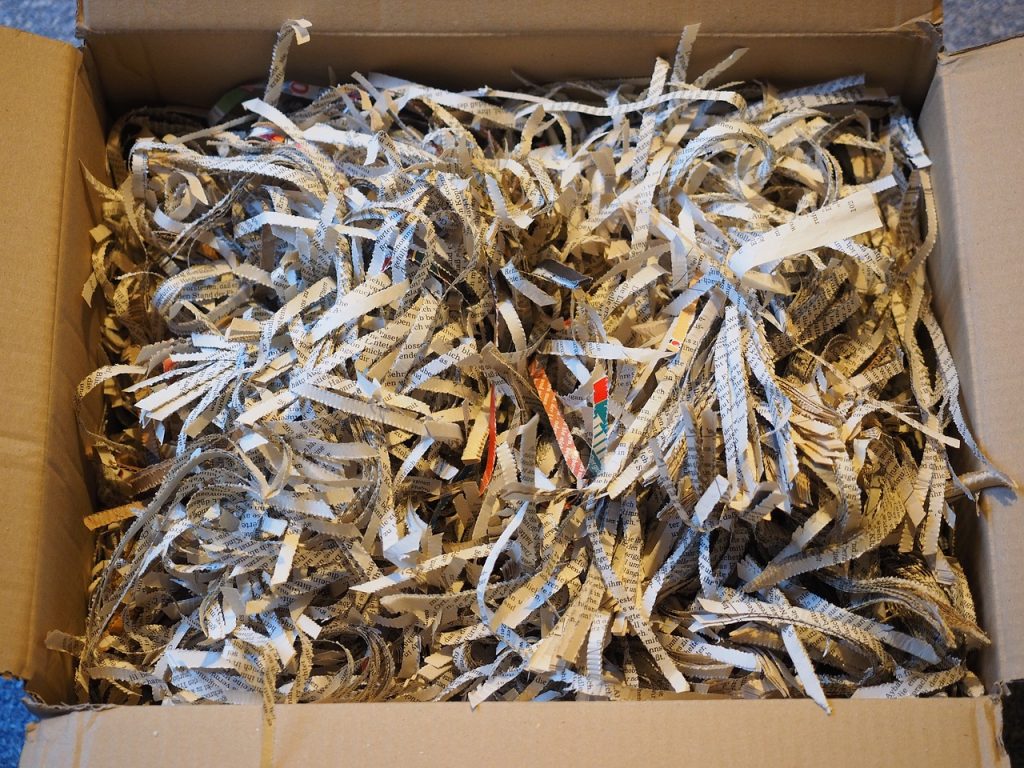- Understand which fabrics are recyclable. Pure products like 100% cotton or wool are easier to recycle than mixed materials.
- Sort your material into piles based on condition and type.
- Donate or resell fabrics in good condition to prevent them from going to waste.
- Utilize scraps beyond recovery as rags or donate them for recycling to local centers or non-profit organizations.
- Get creative and repurpose fabric scraps into crafts, quilts, rag rugs, plush toys, and more.
- Spread the word about textile recycling to inspire others.
- Donate scrap fabrics to organizations that specialize in textile recycling.
Understanding Textile Recycling: An Introduction to Reusing Fabric Scraps
Every year, tons of fabric scraps get tossed in the trash and, eventually, into landfills. At the same time, countless creative projects and businesses are clamoring for affordable materials. With this in mind, recycling fabric scraps becomes a vital part of sustainable living and a successful way to meet a variety of needs. So, understanding textile recycling and learning how to recycle fabric scraps effectively is a practical solution for individuals, businesses, and the health of our planet.
The textile industry is one of the major contributors to waste production in the world. While some fabrics may take a long time to decompose organically, many others are recyclable. They can be shredded, broken down, or repurposed into new items without causing harm to our environment. Fabric scraps can also be reused as rags for cleaning purposes or transformed in a myriad of creative ways, from quilting to stuffing homemade toys.
Recycling fabric scraps not only helps conserve natural resources, but also diminishes pollution caused by landfilling and incineration. Moreover, it provides considerable economic benefits by creating jobs in the recycling and manufacturing industries. Thus, when you recycle, you contribute to a better world, economically and environmentally.
And the exciting part is, anyone can participate in textile recycling. So, how does one navigate the process? First, it is important to know which fabrics are recyclable. Generally, pure products (like 100% cotton or 100% wool) are easier to recycle than mixed or synthetic materials.
Next, you’ll want to sort your material into piles. Fabrics in good condition can be donated or resold. This prevents them from going to waste and provides an affordable option for others who may need them. On the other hand, scraps beyond recovery can be utilized as rags or donated for recycling. Many local recycling centers and non-profit organizations will happily accept fabric scrap donations.
You don’t have to limit yourself to the conventional. If you’re feeling creative, there’s a multitude of crafts and DIY projects that make great use of fabric scraps. From creating colorful banners and quilts to making homemade rag rugs and plush toys, there’s no limit to what you can do with your recycled scraps. Incorporating this mindset of reusing and repurposing into your lifestyle is a fun and fulfilling way to participate in sustainability.
Lastly, be sure to spread the word about the importance of textile recycling and how to recycle fabric scraps. This could be as simple as discussing it with a friend or sharing articles about it on social media. Remember that change often starts small, and your actions can inspire others to recycle more and reduce waste.
In conclusion, understanding and participating in textile recycling is an excellent way of diminishing waste, conserving resources, and promoting sustainability. By learning to recycle fabric scraps effectively – whether by repurposing them into something new, donating them for reuse, or simply using them as rags – we reduce our impact on the environment and enrich our communities. So, start today, do your part, and embrace the endless possibilities that come with recycling.
Recycling Fabric Scraps: An Essential part of Textile Recycling
Recycling fabric scraps is an essential part of textile recycling. When we consider recycling, fabric is often overlooked. However, fabric scraps, whether they’re from worn-out clothes, unused bedding, or offcuts from crafting endeavours, can all be repurposed and recycled to create something new and reduce waste.
Embarking on fabric scrap recycling might seem overwhelming, but remember, recycling is vital. People often don’t realize how many fabric scraps they produce over time. Offcuts from fashion projects, poorly fitting clothing, or items damaged beyond repair add up, contributing to the growing problem of textile waste. But, by recycling these pieces of fabric, we can avoid contributing to this issue.
So, how do you go about recycling fabric scraps? Is there a right way to recycle fabric? Well, yes, there is. Firstly, it’s crucial to sort your fabric scraps. They are not typically recyclable through traditional curbside recycling programs, like paper or plastic, so it’s important to identify where your scraps belong. Organizing your fabric scraps by type helps with this. Many organizations accept specific fabrics for recycling, and keeping them separate at the source makes the recycling process smoother.
Another way to recycle fabric scraps is by finding new uses for them. Fabric scraps can be sewed into quilts, made into rag rugs, woven into baskets, or otherwise repurposed to create entirely new items. Not only does this form of recycling save the fabric from ending up in a landfill, but it’s also an excellent opportunity to unleash your creativity and come up with innovative ways to use these scraps.
Fabric scrap recycling isn’t confined to the home; businesses can also play a significant part in this important process. Companies involved in fashion and textiles, in particular, can have an enormous impact on the volume of fabric recycling that occurs. They can donate leftover fabric or create systems for returning unused materials for recycling. They can also craft products from recycled or reclaimed fabric, signaling to consumers that they’re committed to sustainability.
While it’s essential to recycle fabric scraps, it’s also important not to forget about the fabric itself. Remember, fabric is a resource that was once made at some cost; recycling it acknowledges and respects that original investment. This is definitely an area in which the old saying, ‘waste not, want not,’ offers our planet significant advantages.
Perhaps the most significant insight here is that fabric isn’t a ‘one and done’ commodity. We often think of fabric as something we use and discard, but fabric has an enormous potential for recycling. Using this potential, fabric can become a circular material – made, used, recycled, and then remade. It can have a life far longer than any single garment, and recycling it respects that lifespan.
In summary, fabric scrap recycling is a meaningful and essential part of the textile recycling industry. It brings numerous benefits at individual, organizational, and industry levels, breathing new life into these discarded materials, and promoting sustainable practices. The importance of fabric and fabric scrap recycling can’t be overstated, it’s about time we as a society, embrace it wholeheartedly.
The Right Ways to Recycle: Where to Donate Scrap and the Role of Thrift Stores
So you’ve learnt about the importance of textile recycling and how to reuse fabric scraps, but what happens when you end up with more fabric scraps than you know what to do with? Well, don’t just dump them in the bin. The right ways to recycle vary, but one useful avenue to explore is donating scrap. Yes, you can donate scrap fabrics to organizations and stores that accept them.
One of the simplest ways to recycle your unwanted textiles is by donating them. Why, you might ask? This helps reduce the amount of waste sent to landfills, it’s advantageous in a socio-economic aspect as well, as your donations could help someone in need of a cheaper clothing option. Not to mention that it supports the creation of jobs in the thrift store sector. Thrift stores, often function as a cornerstone of this textile recycling process. They accept scrap fabric and clothes, breathing new life into them before they end up in another individual’s wardrobe.
You see, thrift stores aren’t just a haven for bargain-hunters looking to shop at affordable prices. They’re also a major hub for textile recycling. Every day, these stores receive hundreds of clothes donations, and they’ve got the infrastructure in place to sort, clean, and resell these items. But it’s not just clothes they’re interested in. Scrap fabric donations are also welcomed. Anything from old curtains, bed sheets, table cloths, or any fabric scraps are accepted.
So, where to donate scrap materials? It’s easier than you think. Many healthcare institutions, animal shelters, and art schools accept fabric donations for their day-to-day operations. Others such as quilting groups often accept fabric scraps for their projects. There are also numerous charities that accept clothes and fabric donations, repurposing them to help those in need.
There’s always the option to shop, shop, shop your fabrics away! Hosting a garage sale or listing your scraps on an online marketplace will not only help you clear space but will also give your scraps a second shot at life. There are also numerous textile recycling programs that have drop-off locations at retail stores across the country. Here you can donate your old clothes, or other textile scraps, and these will be broken down and repurposed into something new.
Remember that every little bit helps. A small scrap of fabric might not seem like much, but when you multiply that by the hundreds of clothes donations thrift stores receive daily, it becomes clear that your actions can make a big difference. The process of textile recycling ultimately contributes to a more sustainable future, reducing waste and the demand for new raw materials.
In conclusion, if you have fabric scraps or clothes that you no longer need, don’t add to the waste – donate them. By simply choosing to donate scrap and shop responsibly, you can do your part to reduce waste, support your local thrift stores, and make a positive impact on the environment.
The Importance of Textile Recycling
Textiles, often overlooked in the recycling conversation, hold immense potential for reuse and repurposing. From individual fabric scraps to entire garments, textiles can be given a new life, diverting them from landfills and reducing environmental impact. Every year, vast amounts of textiles are discarded, leading not only to a significant loss of resources but also contributing to environmental degradation.
Understanding the nuances of textile recycling is more than just about waste reduction. It’s about breathing new life into old fabric scraps, championing sustainable fashion, and promoting a more eco-conscious lifestyle. The act of recycling textiles is a testament to the value we place on resources and our commitment to a sustainable future.
Moreover, the textile recycling process is not just limited to repurposing old fabrics. It’s about recognizing the broader cycle these materials undergo, from creation to reuse. By being informed about the recycling process, individuals can make more environmentally-friendly choices, from donating unused textiles to supporting sustainable fashion initiatives.
In conclusion, textile recycling plays a pivotal role in promoting sustainability and reducing environmental impact. By understanding the importance of recycling textiles, individuals can make informed decisions, contribute to a greener future, and champion the ethos of sustainable living.
Responding to Textiles Demands: How to Recycle and Reply to the Changing Environment
Meeting the varying demands of textile recycling isn’t as complicated as it seems. With the constant evolution in the textile industry’s infrastructure and the escalating conversation around environmentally conscious practice, the capacity to recycle fabric scraps has become more than a simple act of philanthropy. It’s a significant response to the cries for change in our environment, a crucial move tailored to mitigate the harsh impacts of textile waste. Textile recycling is now pivotal in fashioning an environment-friendly narrative and providing eco-solutions that make sense.
When people consider recycling, paper, glass, and plastic often come to mind. Interestingly, textiles are also highly recyclable, although many don’t realize this fact. Thus, it’s essential to understand how textiles come into the recycling picture and acknowledge their importance. Recycling textiles extends beyond the ‘reduce, reuse, recycle’ mantra. It’s a significant environmental response, involving widespread initiatives to maintain an eco-friendly textile industry.
Getting fabric scraps or unwanted textiles out of your life and into the right hands is simpler than you think. There are several ways to recycle, and each varies in its impact. For instance, donating lightly used clothes and other textiles to thrift stores or charity organizations does more than decluttering your wardrobe. It creates an avenue for others to reuse what you’ve given up, effectively reducing the total waste generated in the textile industry.
It is necessary to consider, however, that not all textiles qualify for the same kind of recycling process. Part of the process involves sorting and categorizing, which is a critical step to make sure that each piece of fabric can get the maximum utility. After sorting, textiles are processed and transformed into raw material, ready to be utilized in creating new clothing or other textile-based products.
Taking a step to recycle can strongly echo your commitment to the cause of saving the environment. It shows a clear inclination to do your part towards sustainability while encouraging others to do the same. Responding to the transformation in our environment and meeting the demands of textile recycling can seem like a daunting task, but every small step helps.
Finally, it’s essential to know that not all fabric scraps are recyclable. Some textiles, due to their composition or condition, may not be suitable for further use. Nonetheless, this should not deter anyone from recycling. The key is to remain informed about what’s recyclable and what’s not and to make appropriate decisions based on this information.
In sum, recycling is more than just a trend; it’s a lifestyle, a commitment to the environment, a proactive response to the prevailing environmental issues surrounding the textile industry. With the knowledge of where to donate scraps, how textiles are recycled and the role of thrift stores in the recycle chain, anyone can start the recycling journey and thus, make a significant difference in our environment.
Exploring New Dimensions in Fabric Scrap Recycling
For those passionate about sewing and textile recycling, the accumulation of waste in the form of scrap fabric is a pressing concern. As awareness grows about the environmental impact, many are seeking sustainable and practical methods to recycle fabric scraps.
There are organizations dedicated to the sphere of fabric recycling that work diligently to ensure these scraps find a new purpose. Such organizations collaborate with businesses, designers, and individuals to manage textile waste responsibly. They are committed to making sure that fabric scraps, regardless of size or pattern, are repurposed and don’t merely end up in landfills.
Anyone can contribute to the cause of textile recycling. Whether you’re decluttering a home sewing studio or have stumbled upon a stray piece of fabric during a cleanup, even the smallest fabric scraps can be valuable. Donating these materials is not just about freeing up space; it’s a significant step towards a broader environmental initiative.
Privacy is paramount, especially when dealing with proprietary designs and patterns. Responsible organizations maintain strict privacy policies, ensuring that donated materials are handled with care and discretion. This commitment to privacy encourages more designers and businesses to participate, strengthening the textile recycling community.
What sets apart leading organizations in the textile recycling industry is their innovative approach. Embracing the mantra of ‘Recycle, Recycle, Recycle’, they champion environmentally friendly methods to address this often-overlooked waste. Their dedication extends to repurposing scrap fabric in various ways, from crafting larger sewing projects to collaborating with partners to transform scraps into insulation, carpet padding, and other useful products.
Engaging in textile recycling allows individuals to respond proactively to evolving environmental challenges. It’s not merely about repurposing fabric scraps but understanding the broader lifecycle of these materials. Recognizing this cycle and playing a part in it is crucial.
In today’s context, being conscious of the waste we generate, even in hobbies like sewing, is of utmost importance. It’s inspiring to witness the dedication of organizations that are reshaping the fabric scrap recycling landscape, acting as catalysts for positive change in the realm of textile waste.




